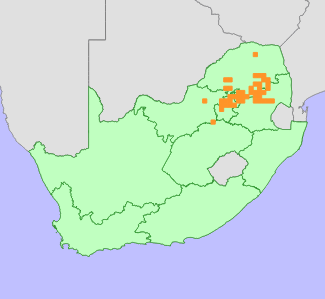|
Scientific Name | Searsia zeyheri (Sond.) Moffett |
Higher Classification | Dicotyledons |
Family | ANACARDIACEAE |
Synonyms | Rhus glaucovirens Engl., Rhus zeyheri Sond., Rhus zeyheri Sond. var. parvifolia Burtt Davy |
Common Names | Blue Currant (e) |
National Status |
Status and Criteria | Least Concern |
Assessment Date | 2020/01/29 |
Assessor(s) | W. Foden & L. Potter |
Justification | Searsia zeyheri is very widespread and common, with an extent of occurrence (EOO) of 95 422 km². A small part of the range is highly transformed, mainly within Gauteng, but habitat loss does not exceed 30%. It is therefore listed as Least Concern. |
Distribution |
Endemism | South African endemic |
Provincial distribution | Gauteng, Limpopo, Mpumalanga, North West |
Range | This species is endemic to South Africa, and is found in the Limpopo Province, Soutpansberg and Blouberg southwards to the Wolkberg and the Mpumalanga escarpment between Steelpoort and Kaapsehoop. From the escarpment it also occurs westwards across the Mpumalanga Highveld to the Magaliesberg Range between Pretoria, Rustenburg and Krugersdorp in Gauteng and North West Province. It is also recorded from the Waterberg. |
Habitat and Ecology |
Major system | Terrestrial |
Major habitats | Central Sandy Bushveld, Rand Highveld Grassland, Gauteng Shale Mountain Bushveld, Carletonville Dolomite Grassland, Andesite Mountain Bushveld, Gold Reef Mountain Bushveld, Marikana Thornveld, Moot Plains Bushveld, Sekhukhune Mountain Bushveld, Egoli Granite Grassland, Sekhukhune Montane Grassland, Loskop Mountain Bushveld, Leolo Summit Sourveld, Lydenburg Thornveld, Northern Escarpment Dolomite Grassland, Northern Escarpment Quartzite Sourveld, Soutpansberg Summit Sourveld, Steenkampsberg Montane Grassland, Dwarsberg-Swartruggens Mountain Bushveld, Norite Koppies Bushveld, Legogote Sour Bushveld, Loskop Thornveld, Waterberg Mountain Bushveld, Soutpansberg Mountain Bushveld, Poung Dolomite Mountain Bushveld, Ohrigstad Mountain Bushveld, Waterberg-Magaliesberg Summit Sourveld |
Description | It occurs on rocky outcrops, slopes and ridges in bushveld, savanna and open woodland. |
Threats |
| Searsia zeyheri is under threat from habitat degradation. |
Population |
There is no information available on the population of this species.
|
Population trend | Stable |
Assessment History |
Taxon assessed |
Status and Criteria |
Citation/Red List version | | Searsia zeyheri (Sond.) Moffett | Least Concern | Raimondo et al. (2009) | |
Bibliography |
Coates Palgrave, M. 2002. Keith Coates Palgrave Trees of southern Africa. 3rd Edition. Struik, Cape Town.
Moffett, R.O. 1993. Rhus. In: O.A. Leistner (ed). Flora of southern Africa 19 Part 3: Anacardiaceae, Fascicle 1:1-129. National Botanical Institute, Pretoria.
Moffett, R.O. 2007. Name changes in the Old World Rhus and recognition of Searsia (Anacardiaceae). Bothalia 37(2):165-175.
Raimondo, D., von Staden, L., Foden, W., Victor, J.E., Helme, N.A., Turner, R.C., Kamundi, D.A. and Manyama, P.A. 2009. Red List of South African Plants. Strelitzia 25. South African National Biodiversity Institute, Pretoria.
Schmidt, E., Lotter, M. and McCleland, W. 2002. Trees and shrubs of Mpumalanga and Kruger National Park. Jacana, Johannesburg.
|
Citation |
| Foden, W. & Potter, L. 2020. Searsia zeyheri (Sond.) Moffett. National Assessment: Red List of South African Plants version 2024.1. Accessed on 2025/10/30 |
 Comment on this assessment
Comment on this assessment

